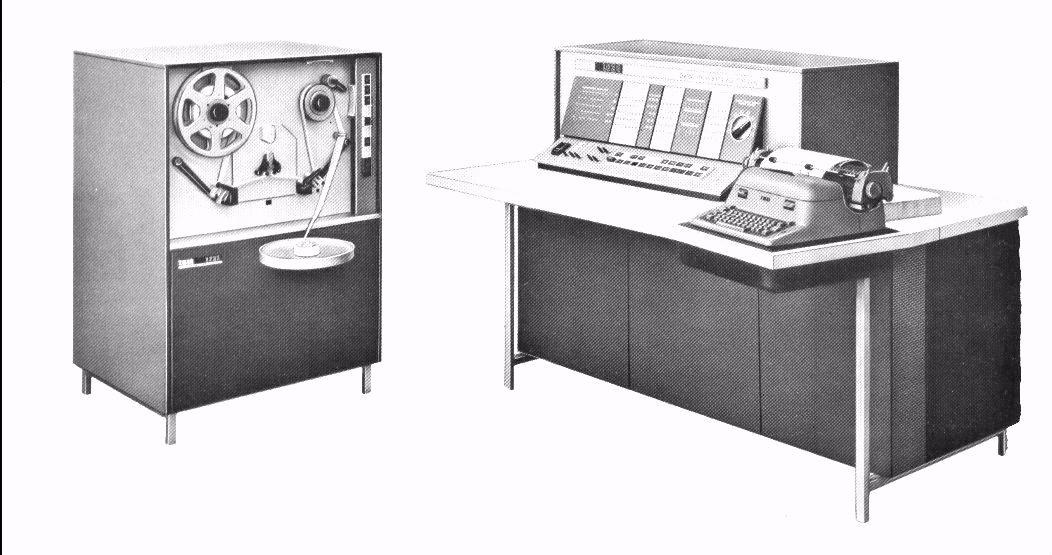The IBM 1620 Data Processing System

The basic IBM 1620 Model 1 Data Processing System, 1959-1970, photo from the Computer Museum History Center. This is not the 1620 in Watson Lab. The 1620 was relatively small and inexpensive for its day. The Model 1 used paper tape (drive pictured left above) for I/O, plus a typewriter console for interactive control and printed output. One of IBM's last decimal machines (the internal format for numbers was BCD, with sign and parity bits), the 1620's nickname was CADET (Can't Add Doesn't Even Try) because addition was accomplished using lookup tables rather than adders (similarly for subraction and multiplication, and there was no DIVIDE instruction at all; division was done in software). Programmed in SPS (Symbolic Programming System, the 1620 assembler) and FORTRAN (designed by Watson Lab alumnus John Backus), which were both available from Day One. It is apparent that the 1620 Model 1 owes a great deal to its predecessor, the 610 Auto-Point Computer (IBM's first attempt at a small scientific computer); the main differences are core memory instead of drum, no plugboard (the 1620 was a true stored-program computer rather than a "Turing machine" with a long tape), and a standard high-level programming language.
The Model 2 included true arithmetic and greater I/O capabilities, including punched cards. The 1620's business-oriented counterpart was the 1400 series. A variation of the 1620 was the 1710, which had analog/digital converters, interrupts, and other features needed for industrial process control.
From Mike Radow, formerly of Watson Lab:
By 1959 -- or 1960, at the latest -- "Watson north" had a small IBM 1620 in a corner of the upstairs room, behind the 650. As HS "Science Honors" students, Paul Schneck -- later to go to NASA and now the Director of NSA's Super-Computing Research Center -- and I would often write programs to race the already-then-ancient 650 against the transistorized(!) 1620.It was then that I (sadly) learned that algorithms are just as (if not more) important than a machine's raw access and cycle times!
The 1620 multiplied and divided by using tables stored in memory. As you'd expect, a common and sophomoric stunt was to load the tables with corrupted values, making a friend's program produce garbage. Sometimes, a newbie could be convinced that the 1620 was broken and producing incorrect results ... but only once. I soon learned never to pull this stunt on grad students, especially if they were taller than me...
From Bill Principe, 16 Sep 2005:
I saw your 1401 and 1620 pages on the Internet. As an undergrad at Berkeley in the 60s, I had part-time jobs working on both machines. I'd like to share a 1620 anecdote.There used to be a program for the 1620 that worked line this. You put an AM radio on the CPU console, and tuned it for the loudest noise. (They generated a lot of random RF noise that could play havoc on nearby electronic equipment.) Then you fed a deck of cards with the program. The radio would play "Stars and Stripes Forever" and the line printer would play the drum rolls. I'd like to see a Pentium IV laptop do that!

A fully configured IBM 1620 Model 2 computer system with 1311 disc drive, 1621 paper tape unit, 1625 core storage unit (20K-60K), 1622 card reader/punch, 1443 line printer and some unit-record equipment. Photo from the Technology Museum of Thessaloniki, Greece.

|
| IBM marketing photo of the 1620. |

|
| A closeup of the 1620 control panel. |
- 1620 Data Processing System (IBM), accessed 25 May 2019.
- IBM 1620 Project Journal, Computer History Museum, accessed 25 May 2019.
- IBM 1620, Wikipedia, accessed 25 May 2019.
- The Foodman IBM 1620 page
- The IBM 1620 at Chula (Thailand)
- The Technology Museum of Thessoloniki (Greece)
- Andree, Richard V., Computer programming and related mathematics for the IBM 1620 computer.
Translations of this page courtesy of...
| Language | Link | Date | Translator | Organization |
|---|---|---|---|---|
| Belarusian | Беларуская | 2023/08/22 | Vladyslav Byshuk | Владислав Бишук | studybounty.com |
| Finnish | Suomi | 2023/08/31 | Kerstin Schmidt | writemyessay4me.org |
| French | Français | 2023/08/31 | Kerstin Schmidt | prothesiswriter.com |
| German | Deutsch | 2023/08/31 | Kerstin Schmidt | writemypaper4me.org |
| Italian | Italiano | 2023/08/31 | Kerstin Schmidt | admission-writer.com |
| Polish | Polski | 2023/08/31 | Kerstin Schmidt | justdomyhomework.com |
| Russian | Русский | 2023-07-16 | Alexey | Plastic Recycling Company |
| Spanish | Español | 2023/08/31 | Kerstin Schmidt | pro-academic-writers.com |
| Slovak | Slovenčina | 2023/08/22 | Vladyslav Byshuk | Владислав Бишук | studycrumb.com |
| Ukrainian | Українська | 2023/08/22 | Vladyslav Byshuk | Владислав Бишук | skyclinic.ua |